- Details
- Published on 08 March 2018
Vol. 610
In section 1. Letters to the Editor
Sub-arcsecond imaging of Arp299-A at 150 MHz with LOFAR: Evidence for a starburst-driven outflow
 Starbursts in merging galaxies can provide spectacular outflows, due to supernovae feedback. The starburst in the Arp 299 pair of colliding galaxies is here shown to provide a huge outflow, of about 5kpc in length, perpendicular to one of the disks. The outflow is remarkable in the high-resolution (0.4 arcsec) image at 150 MHz obtained with the International Low Frequency Array (LOFAR) Telescope. The filamentary outflowing structure accounts for almost 40% of the extended emission of the entire galaxy system.
The structure coincides with the ionized gas outflow imaged with HST/NICMOS in the [FeII] and H2 2 mumicron lines. The outflow is also confirmed through Na I D spectra. The low-luminosity AGN in this galaxy would be insufficient to drive this outflow, contrary to the powerful and compact nuclear starburst. The outflow corresponds to 10-60 Mo/yr at a velocity 400-800km/s. This work shows that subarcsecond imaging with LOFAR might be an excellent new tool with which to unveil outflows in the central regions of local luminous infrared galaxies.
Starbursts in merging galaxies can provide spectacular outflows, due to supernovae feedback. The starburst in the Arp 299 pair of colliding galaxies is here shown to provide a huge outflow, of about 5kpc in length, perpendicular to one of the disks. The outflow is remarkable in the high-resolution (0.4 arcsec) image at 150 MHz obtained with the International Low Frequency Array (LOFAR) Telescope. The filamentary outflowing structure accounts for almost 40% of the extended emission of the entire galaxy system.
The structure coincides with the ionized gas outflow imaged with HST/NICMOS in the [FeII] and H2 2 mumicron lines. The outflow is also confirmed through Na I D spectra. The low-luminosity AGN in this galaxy would be insufficient to drive this outflow, contrary to the powerful and compact nuclear starburst. The outflow corresponds to 10-60 Mo/yr at a velocity 400-800km/s. This work shows that subarcsecond imaging with LOFAR might be an excellent new tool with which to unveil outflows in the central regions of local luminous infrared galaxies.


